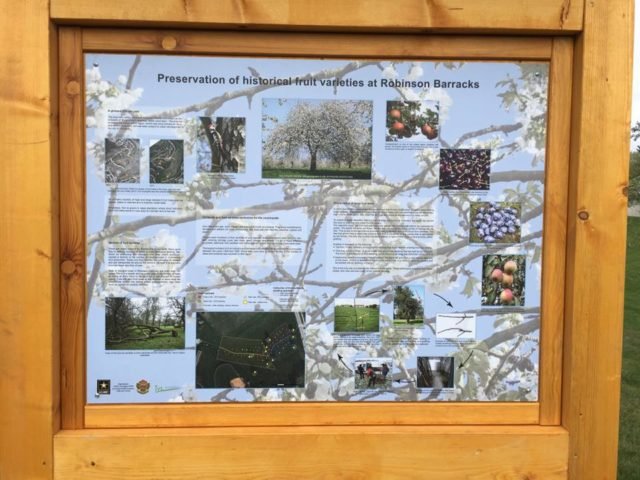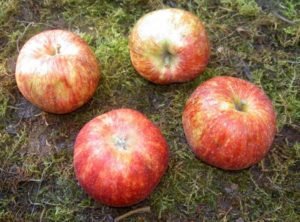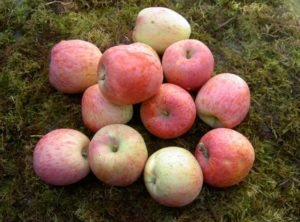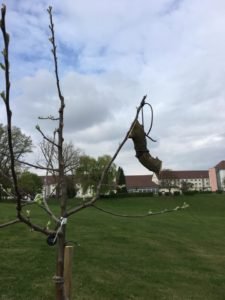
By Holly DeCarlo-White
USAG Stuttgart Public Affairs
If you haven’t walked through the Robinson Barracks (RB) orchard lately, the U.S. Army Garrison Stuttgart Directorate of Public Works Environmental Division, together with host nation partners, recently installed new signage to identify and track the various fruits growing as part of an ongoing conservation project.
An informational sign depicting the growing tree and fruit type descriptions was installed in March.
“I highly recommend it,” said Rebecca Rodriguez, RB community member, referring to the orchard. “A new sign explains the history and preservation work of the orchard. It’s a delightful read for plant nerds, history lovers and all people who like fruit.”
“The conservation program not only focuses on endangered species, but biodiversity including historical fruit varieties,” said Inga Gebhard, conservation manager, DPW Environmental Division. “The program preserves biodiversity and the cultural heritage because if one of the old trees falls, the fruit variety might be lost in the region forever,”

Many trees and fruit types are older than the installations themselves, between 80 and 100 years old. Since the project began in 2014, about 900 old fruit trees were surveyed on RB, Patch Barracks and the Stuttgart Golf Course in Kornwestheim, identifying hundreds of historic fruit varieties. The majority of the trees are located at the golf course where orchards were planted some 70 years ago.
According to Gebhard, it was important to the people at the time to use the areas in between fairways for a purpose to harvest the fruit, make juice, etc.
“The area also serves as a home for endangered species. Cavities in old fruit trees are where bats can hibernate and birds such as woodpeckers and owls can thrive. Blooming fruit trees are also important for wild bees and other insects. As part of the National Military Wildlife Pollinator Program, military installations should preserve blooming areas for pollinators like this,” Gebhard said.
Historic fruit tree preservation is a joint effort of the garrison and regional stakeholders. For example, local farmers preserve the diverse orchards habitats by mowing only once a year. Stuttgart Family and Morale, Welfare and Recreation works with the City of Kornwestheim to care for the old trees and newly planted areas. Dr. Ottmar Funk of the German Union for Nature Conservation (NABU) and chairman of the ecology group Natur and Umwelt Kornwestheim contributes and plants 10 fruit trees each year. Ottmar also hangs nesting boxes for birds.

“This is a very important and unique partnership we have in the region. We have seen our host nation relationship grow over the past 10 years with this program. It is something we want to develop and continue in the future to further our German-American relationship,” Gebhard said.
Specialists, including biologists and botanists, worked to survey the trees to determine their varieties. Local expert Zori Dierolf helped to identify several of the fruit types by comparing the samples to her own database records of more than 2,000 fruit varieties that grow only in Ludwigsburg County. Dierolf also determined if a tree was a rare or common type in the region.
“We had grafting twigs for the rare types sent to a tree nursery to grow new trees. We brought them in to preserve the landscape and habitat, but also planted them in order to preserve the fruit varieties,” Gebhard said.

Since the start of the program, more than 120 trees have been planted from grafted twigs, 70 at the golf course and the rest divided among Patch and RB. Grafting and cultivation is the only method to preserve and grow the fruit type because the seed of an apple does not carry the original variety. The seeds would grow a new wild fruit type.
Any apples or pears on base are edible, however, one needs to know when to pick and how to prepare the fruit for the best taste.
“Some may taste tart or sour, some are ready to eat. The sour ones are better for storage, juice or preserves,” said Gebhard. “Each fruit type has a purpose for the kitchen. Having a variety was important to the farmers so that the fruit was not arriving at the same time, and it was good for making all sorts of preserves, juice and products to have vitamins during the winter.”
DPW Environmental is planning an exhibition in the fall on rare fruit types that grow in the Stuttgart area and will continue to install small signs explaining the use of the fruit.
“We really do live on a beautiful post in an amazing area and kudos to the garrison for their environmental efforts!” said Rebecca Rodriguez, RB community member.
New plantings of orchard trees can be found throughout the Stuttgart Golf Course and RB, as well as on Floridastrasse and around the Patch Community Club on Patch Barracks.
Subscribe to stuttgartcitizen.com email updates to stay informed on upcoming events.
